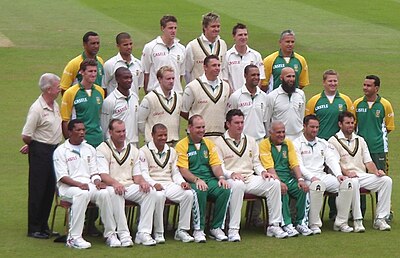The South African cricket team toured England in 1947. At Nottingham, Captain Alan Melville and vice-captain, Dave Nourse achieved a Test match record for a third wicket partnership of 319. The following year Nourse, 38 year old captain of Natal, was appointed Captain for the 1948 MCC Test matches in South Africa.[5]
In 1970, the ICC voted to suspend South Africa from international cricket indefinitely because of its government's policy of apartheid, a policy which led them to play only against the white nations (England, Australia, New Zealand), and field only white players. This decision excluded players such as Graeme Pollock, Barry Richards and Mike Procter from partaking in international Test Cricket. It would also cause the emigration of future stars like Allan Lamb and Robin Smith, who both played for England, and Kepler Wessels, who initially played for Australia, before returning to South Africa.
The ICC reinstated South Africa as a Test nation in 1991 after the deconstruction of apartheid, and the team played its first sanctioned match since 1970 (and its first ever One-Day International) against Indiain Calcutta on 10 November 1991. South Africa's first test match after re-admission was against theWest Indies in April 1992. The match was played in Bridgetown, Barbados and South Africa lost by 52 runs.
Since South Africa have been reinstated they have achieved mixed success, and hosted the International Cricket Council Cricket World Cup in 2003. However, it is widely believed[by whom?] the sides containing the likes of Allan Donald, Shaun Pollock, Gary Kirsten and Hansie Cronje grossly underachieved, gaining a reputation as "chokers", due to them reaching the semi-finals of the Cricket World Cup three times, but failing to progress into the finals. In the second part of the 1990s, South Africa had the highest winning percentage in ODIs of any team, but they were knocked out of the 1996 World Cup in the quarter-finals, and then were eliminated on countback after tying their semi-final against Australia in 1999. In 2003, South Africa were one of the favourites but were eliminated by one run in the group stages after they had mistakenly counted the number of runs they needed.
They have also had bad press for failing in vital matches in global tournaments including the 2002 ICC Champions Trophy and the 2007 ICC World Twenty20.[6]
With Donald retiring, Cronje banned for match-fixing and later dead in a plane crash, and Pollock also retiring from international cricket, the team has once again changed shape. It is currently captained by Graeme Smith, although following injuries to Smith and Jacques Kallis, Ashwell Prince deputised as Test captain on 12 July 2006. At the age of 29, he became the first non-white man to captain the once all-white South African cricket team. Due to a racial quota policy, the side was once required to contain black players, unlike the past. However, that policy was rescinded in 2007.[7]
Tournaments[edit]
South Africa has a record of failing to win major tournaments and is much-maligned because of this. The 1992 Cricket World Cup, for example, featured a rain-affected semi-final played before the introduction of the Duckworth-Lewis rain rule. South Africa needed 22 runs from 13 balls when rain intervened. After the delay they were left in the situation of requiring 22 runs from one ball in order to progress. In 1996 they were eliminated in the quarter-finals despite being one of the fancied teams and having qualified first in their group.
South Africa hosted the 2003 Cricket World Cup, but failed to progress beyond the group stage due to a misunderstanding of how many runs they needed to score in a rain-affected run chase. As a result of this, Shaun Pollock resigned as captain and was replaced by young batsman Graeme Smith, although Pollock continued to play for the team. Under Smith's leadership, South Africa has achieved some success, although they have been hampered by the retirements of many star players, including fast bowler Allan Donaldand one-day specialist Jonty Rhodes. As a result, they had a poor 2004, only winning against the West Indies.
In the 2007 World Cup they had a rollercoaster ride that included dominant wins over England, the West Indies, Ireland, Netherlands and Scotland, and a narrow win over Sri Lanka, but devastating losses to Australia, New Zealand and Bangladesh that cost them the number one ranking. Then they bowed out in the semifinals with their lowest ever score in a World Cup as Australia bowled them out for 149 and won by 7 wickets.
In the 2011 World Cup, South Africa topped Group B with the distinction of bowling out every side they played within the 50 over limit. In the quarter final they were beaten by New Zealand after suffering a dramatic collapse and losing eight wickets for 68 runs. They also hold the record of the highest successful run chase and made the highest total (the latter record has been surpassed) in One-Day Internationals (438-9 in 49.5 overs), in an iconic match against Australia on 12 March 2006. This game is considered by many to be the greatest One-Day International ever played.
South Africa beat Netherlands by 231 runs in Mohali in Group matches in ICC World Cup 2011, The 231-run win is the fourth largest margin of victory for any team in World Cups and the largest for South Africa in World Cups. It is also the second largest margin of victory for South Africa in ODIs on 3 March 2011.[8] The 87-run stand between JP Duminy andColin Ingram is the highest for the sixth wicket for South Africa in World Cups. The highest sixth-wicket stand for South Africa in ODIs is the 137 between Hansie Cronje and Shaun Pollock against Zimbabwe in 1997. The triumph is South Africa's seventh by a fringe of hundred or more runs in World Cups.[9]

No comments:
Post a Comment